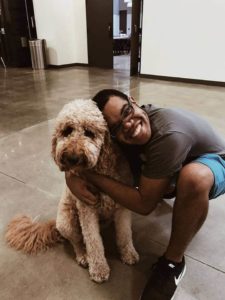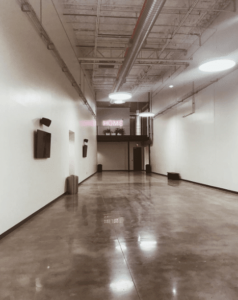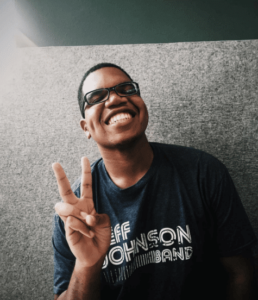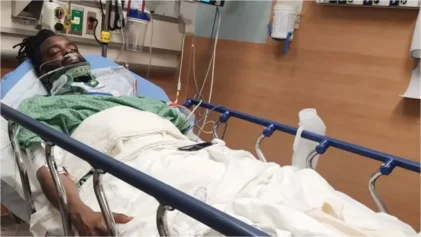
Garren Fain and a furry friend (Photo: Instagram)
In 2009, Garren Fain moved from Columbia, S.C., where a new job opportunity awaited his mom in Atlanta, Ga. He was in seventh grade when his familiarity with the world was abruptly shifted.
“I moved away from my friends and family, [with] no father figure, and Atlanta is a much bigger city than Columbia, so that’s a lot for a seventh-grader to take in.” Fain said.
Garren was diagnosed with depression and bipolar disorder in 2017, but he noticed a change in his behavior after that move — a feeling of sadness and not belonging lingered throughout his transition to the bigger city and far after.
“I’ve had three failed suicide attempts. I think it was a combination of not thinking that my situation would ever get better and anxiety,” Fain said. “I would get this overwhelming feeling of a gigantic rock just resting on my chest, and it felt like it would get heavier every time I tried to breath.
“This is a feeling I still struggle with, but on those days, I had no sense of hope. I didn’t think it would go away, so I tried to end my life.”
Now at 20 years old, Garren spends most of his time at home reading or at Passion City Church, where he was able to build a relationship with God and a reason to live.
“I started attending Passion City Church and I started

The halls of Passion City Church, where Fain found solace. (Photo: Instagram)
having conversations that I never thought I would have,” Fain said. “Those conversations have opened up my mind to the option of going to a counselor.”
But Fain said he often still struggles with getting his family to understand or take his health seriously. Coming from a Black, single-parent household, he said he often heard phrases like “Get over it” or “You’re too sensitive” when discussing his mental health, whereas, around his white peers, he found a more willing and sympathetic ear. Because of this, he said he still finds it difficult to speak about his mental health without guilt or shame, though he is open to seeking counseling.
According to the 2014 U.S. Census , 13.2 percent of the population identifies as Black or African-American and, of those, 16 percent were diagnosed with a mental illness. That’s over 6.8 million people. African-Americans are 10 percent more likely to report having a serious psychological distress than non-Hispanic whites but are 20 percent less likely to report serious psychological distress than white adults. And while Black teenagers are less likely to die from suicide than white teenagers, they are more likely to attempt it at 8.3 percent. Despite these numbers, there seems to be a disparity in the number of Black people who receive care or treatment for their mental health struggles. According to the American Psychological Association, Black adults, specifically those with higher levels of education, are significantly less likely to seek treatment for their mental health concerns. Black people are disproportionately struggling with mental illness but are not seeking out the help they need.
While racism, oppression and subjugation are embedded in the Black experience, a collective strength also is rooted in the unique Black experience, which pushes many to “survive and do well.” But the disparities that littered African-American communities in and before the 20th century still affect many Blacks today. According to the Pew Research Center, African-American children were four times more likely to live in poverty than white or Asian children in 2013. Black and Hispanic students also were more likely to attend high-poverty schools, where students experience a deprivation of valuable resources, less rigorous curricula and less push for academic success.

Poverty is negatively linked to mental illness. (Photo by Lujoma NY)
A distinct relationship exists between social class and mental illness — the lower an individual is in social class, the more they are susceptible to mental illness. According to the Center of Disease Control, 8.7 percent of people with incomes under the poverty line reported serious psychological distress. Poverty disproportionately affects Black and brown people in American, with a high concentration in urban areas. With less access to resources and high stress from unemployment, unaffordable housing, homelessness and exposure to violence, individuals who live in high-poverty areas become more susceptible to mental distress.
Alongside poverty, racism and discrimination have been shown to negatively affect physical and mental health. Research found that hostile and character-based discrimination, disrespect and arrogance from white people seem to place African-Americans at greater risk of anxiety, depression and substance abuse problems. While negative stereotypes and extreme hostile racial environments are not as rampant as they were in the early 20th century, they still continue to occur with consequences through micro-aggression, internalized behavior, systematic oppression and colorism.
According to the Health and Human Services Office of Minority Health, African-Americans are 20 percent more likely to experience serious mental health problems than the general population. While mental health is equally as important as physical health, Blacks aren’t seeking the help they need at the same rates. One reason for this can be attributed to the stigma and perceptions that surrounds mental illness.
The responses Fain received from many of his relatives, and the fear of discussing his issue, isn’t an isolated occurrence. A 2008 study found that over one-third of African-Americans who are seeking treatment believe talking about their anxiety may lead to them being called “crazy” by their peers. This fear of being judged for seeking help creates a reluctance among African-Americans to seek help because of the fear that it may badly affect their families.
Licensed clinical social worker TeKesha Smith has seen the stigma throughout her work and recognizes how the stigma varies across cultural lines, specifically between African-Americans who face mental illness in comparison with white Americans.
“Amongst the white community, it’s more understandable and acceptable to go get mental health treatment. In the African-American community, it’s seen as a weakness or as a level of incompetence.”
The stigma initially stemmed from a misunderstanding about mental health, but it has grown into what Smith believes is a dangerous and deadly ideology that prevents Black people from seeking the help they need. This keeps many Black people from recognizing the signs and symptoms of mental health conditions that may be lingering; they write it off as having “the blues” or just being reckless.

The Black church plays a large role in why Black people don’t seek mental health care.
Strong religious beliefs also can prevent people from seeking treatment for their mental
health issues. Family, community and spirituality are great sources of support, and many times psychologists incorporate religion and spirituality in psychotherapy. But relying solely on these institutions as a primary refuge for mental illness does not sufficiently address these issues.
In 2012, Psychiatrist William Lawson spoke with NPR about the role of the Black church in mental health care. He noted that African-Americans who tend to seek help from the church aren’t aware that mental disorders are medical problems and define it as a spiritual weakness rather than a disorder that arises from an imbalance of chemicals in your brain.
“Unfortunately, many individuals believe they can pray away the severe mental depression or schizophrenia, when they need a higher level of care.” Smith said.
There are many other factors that contribute to African-Americans not seeking the care they need, an inability to access affordable mental health services and cultural incompetence in the mental health care field that create a disconnect between Black patients and their white psychologist among them. But to begin breaking down those barriers, we must acknowledge that mental health issues are real and make an effort to erase the stigma, Smith said.
Steps being made toward improving mental health awareness in nonwhite communities have been taking. In 2008, July was named National Minority Mental Health Awareness Month, meant to improve access to mental health treatment and grow public awareness to mental illnesses among nonwhite. In June of 2013, President Barack Obama hosted the National Conference of Mental Health to discuss raising awareness for mental health, and in 2014, the Affordable Care Act created one of the largest expansions to mental health care and substance use disorder coverage in a decade by providing protection for 62 million Americans, covering preventive services (depression screenings, behavioral assessments, etc.) and covering pre-existing health conditions. In 2001, African-Americans accounted for just 2 percent of psychologists in America, but this number increased to 5.3 percent in 2013.
“You see more African-Americans working in the field of mental health care, you’re starting to see more mental health courts throughout the state [of Georgia], that incorporate people of color,” Smith said.
“We’ve developed social empowerment programs, and I’ve seen more investments in education,” she added. “There’s more free mental health clinics. By placing these programs and facilities within our communities and not limiting or restricting individuals, they can still receive service on a slide scale or for free.”

Garren Fain in August 2016. (Photo: Instagram)
Fain says he still has a problems with closing himself off to others and not allowing people to join him on this journey but says he has a strong support system backing him, even during his hardest moments.
He plans to continue seeing a counselor and working on trusting and holding onto relationships that he’s built. He’s made a point to communicate more and earlier to keep from falling into the same dark hole he found himself before and hopes to become an advocate for mental health awareness by creating a safe space for others to talk and share their struggles.
“The stigma is still there, but because of the love that others have shown me, I’m willing to open up more instead of shutting down around those who don’t understand,” he said. “I want to help them understand.”


